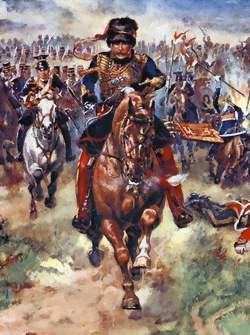

We began by building a mathematical model of the charge. To answer those questions, I collaborated with history student David Connors and history professor John Bonnett on an interdisciplinary study.
#The last charge of the light brigade movie
The battle scene as depicted in the movie “The Charge of the Light Brigade”

Which leader(s) deserved the blame for the disastrous charge? And could it have succeeded if it had followed one of the other alternatives? The leaders’ bickering ignited two ongoing historical debates. But Lucan halted it once he saw the cannon fire’s intensity. That brigade actually had started to advance. Lucan in turn complained that Raglan’s orders had been unclear and unwise.įor his part, Cardigan complained the Heavy Brigade should have charged too, to support his men. The charge was supposed to target Russian cannons on the heights, not in the valley.

Raglan complained the Lucan had ineptly misinterpreted his orders. Either unit could charge cannons, but normally from their defenceless flanks, not head-on into their gunfire. It could overpower lighter cavalry or charge against infantry lines. The Heavy Brigade had larger, stronger horses. In battle it typically charged enemy troops who were disorganised or retreating. The Light Brigade rode smaller, faster horses. The British army commander, Lord Raglan, had issued notoriously vague orders to his cavalry commander, Lord Lucan: “Lord Raglan wishes the cavalry to advance rapidly to the front, and to try to prevent the enemy carrying away the guns.”īut which cavalry: the Light Brigade alone or the Heavy Brigade too? Which guns: those in the valley or those on the adjacent Causeway Heights? The British leaders immediately blamed each other for the fiasco. Outnumbered 11-to-1, the 195 survivors retreated. The ‘Valley of Death’ĭuring the charge, Lord Cardigan’s light cavalry brigade attacked Russian cannons in “the valley of death.” The brigade defeated the gunners, but was counter-attacked by roughly 2,160 Russian light cavalry. It quickly inspired a magnificent poem by Lord Tennyson and later a colourful movie. But it became infamous for its brave soldiers, incompetent leaders and senseless bloodshed. That was a small engagement that ended the inconclusive Battle of Balaclava on Oct. However, another of its features also remains in our memories: The Charge of the Light Brigade. That war is largely forgotten now, apart from its famous nurse Florence Nightingale. Those descriptions sound like Russia’s 2014 takeover of Crimea.īut they also applied 150 years earlier during The Crimean War between Russia and a British-French-Turkish alliance. Western nations’ warships in the Black Sea. That's the final image we get off the battle itself, the remnants of the Light Brigade moving back across the field.Middle East tensions.The speaker doesn't say how many make it to safety, but we're guessing that it's a small number. In this case, though, the tone is much darker, and the emphasis is on how many men have died.This stanza ends with the words "six hundred" just like all the others did.Of course the big difference is that there are a lot fewer of them now.īack from the mouth of hell, All that was left of them, Left of six hundred.

They run into the mouth…they run back again. In a way, it's almost like watching a movie played backward. At the beginning of the poem we heard about how they were going "Into the jaws of Death" and now they are coming out again.Now, a part of the Light Brigade returns back to safety, after having "fought so well.".They that had fought so well Came through the jaws of Death, Notice also that this is the first time that the speaker comes out and calls these men heroes, although that's clearly been the message from the beginning.Here we get an image of horses and soldiers collapsing under the rain of gunfire.As we learn about the retreat from the charge, the poem emphasizes the loss of life.Repetition is an important tool that helps him achieve that effect. Even though he's describing really awful stuff, Tennyson still manages to give this poem a nice feeling of balance.The return trip is just as deadly and terrifying, it's just turned around.The cannon that were in front of them are now behind them, which means that the Light Brigade has turned around and leaving the enemy behind them. Feeling a bit of déjà vu? You should be, because these lines are almost an exact repeat of the beginning of the third stanza (lines 18-22).Cannon to right of them, Cannon to left of them, Cannon behind them Volleyed and thundered Stormed at with shot and shell,


 0 kommentar(er)
0 kommentar(er)
